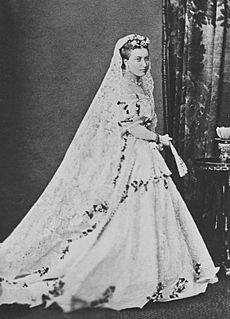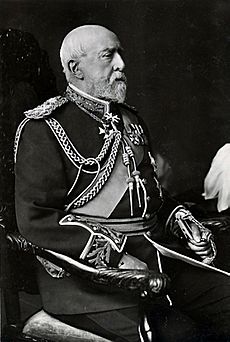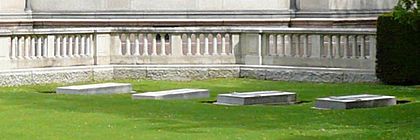Princess Helena of the United Kingdom facts for kids
Quick facts for kids Helena |
|||||
|---|---|---|---|---|---|
| Princess Christian of Schleswig-Holstein | |||||
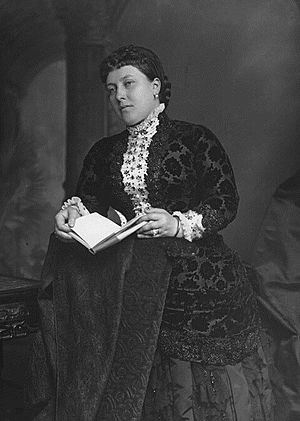
Photo by Alexander Bassano, c. 1882
|
|||||
| Born | 25 May 1846 Buckingham Palace, London |
||||
| Died | 9 June 1923 (aged 77) Schomberg House, London |
||||
| Burial | 15 June 1923 Royal Vault, St George's Chapel, Windsor Castle 28 October 1928 Royal Burial Ground, Frogmore |
||||
| Spouse | |||||
| Issue more... |
|
||||
|
|||||
| House | Saxe-Coburg and Gotha (until 1917) Windsor (from 1917) |
||||
| Father | Prince Albert of Saxe-Coburg and Gotha | ||||
| Mother | Queen Victoria of the United Kingdom | ||||
Princess Helena VA CI GBE RRC (born Helena Augusta Victoria; 25 May 1846 – 9 June 1923) was a daughter of Queen Victoria and Prince Albert. She was their third daughter and fifth child. Later, she became known as Princess Christian of Schleswig-Holstein after her marriage.
Helena was taught by private teachers chosen by her father. She spent her childhood traveling between royal homes in Britain. Her father died in 1861, and her mother, Queen Victoria, became very sad. In 1866, Helena married Prince Christian of Schleswig-Holstein. They stayed in Britain, close to the Queen.
Helena became one of the Queen's unofficial secretaries, helping her with letters and other tasks. She was also very active in charity work. She helped start the British Red Cross and was president of several nursing groups. In 1916, she was the first in her family to celebrate her 50th wedding anniversary. Her husband died a year later. Helena passed away in 1923 at the age of 77.
Contents
Early Life of Princess Helena
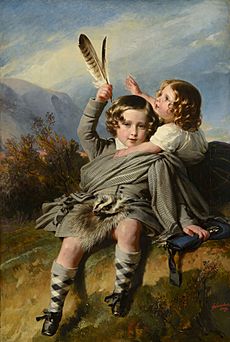
Princess Helena was born at Buckingham Palace in London on 25 May 1846. This was the day after her mother's 27th birthday. Her father, Prince Albert, wrote that she was "quite well now." They named her Helena Augusta Victoria. Her family often called her Lenchen.
As a daughter of the Queen, she was known as Her Royal Highness The Princess Helena from birth. She was baptized on 25 July 1846 at Buckingham Palace.
Helena was a lively and strong-willed child. She was good at drawing from a young age. Like her sisters, she learned to play the piano very well. She also liked science and technology, just like her father. Horseback riding and boating were also favorite activities.
Sadness After Prince Albert's Death
Helena's father, Prince Albert, died on 14 December 1861. Queen Victoria was heartbroken. She moved her family to Osborne House on the Isle of Wight. Helena was also very sad. She wrote that she "adored Papa" and that his word was "most sacred law."
The Queen relied on her older sister, Princess Alice, to help her. When Alice married in 1862, Helena took on the role of helping her mother. She wrote letters for the Queen and kept her company.
Helena's Marriage and Family Life
Engagement and Wedding Day
Helena's engagement was announced on 5 December 1865. Her wedding to Prince Christian of Schleswig-Holstein took place on 5 July 1866. The ceremony was held at Windsor Castle, in the Private Chapel. Queen Victoria wore a white mourning cap with her black dress.
Christian entered the chapel with his supporters. Helena was walked down the aisle by her mother and the Prince of Wales. Some people thought Christian looked older than he was. The couple spent their first night at Osborne House. Then, they went on their honeymoon to Paris and other places.
Life as a Married Princess
Helena and Christian were very close. They lived a quiet life compared to Helena's sisters. They lived at Cumberland Lodge in Windsor Great Park. When in London, they stayed at Buckingham Palace.
The couple had six children:
- Christian Victor (born 1867)
- Albert (born 1869)
- Helena Victoria (born 1870)
- Marie Louise (born 1872)
- Prince Harald (died as a baby in 1876)
- An unnamed stillborn son (1877)
The British Parliament gave Helena and Christian money each year. Christian was also given honorary jobs, like Ranger of Windsor Park. He enjoyed playing with his dog and feeding his pigeons.
Helena lived close to the Queen, as promised. She and her sister Beatrice helped the Queen with various duties. Helena took on the smaller tasks. Later, her unmarried daughter, Helena Victoria, also helped the Queen.
Helena sometimes had health problems. However, Queen Victoria sometimes thought Helena was just imagining her illnesses. But Helena did suffer from serious issues like rheumatism and lung problems.
Helena's Public Work
Helping Nurses
Helena was very interested in nursing. In 1870, she became the first chair of the Ladies' Committee of the British Red Cross. She helped recruit nurses and organize supplies during the Franco-Prussian War.
Later, she became President of the British Nurses' Association (RBNA) in 1887. This group received a "Royal" title in 1891. Helena strongly supported the idea of official nurse registration. This idea was not supported by Florence Nightingale and other important people.
In 1893, Helena said the RBNA wanted to improve the education and standing of nurses. She warned about the challenges they faced. Even though the RBNA wanted formal registration, they were allowed to keep a list of nurses instead.
After Queen Victoria died in 1901, the new Queen, Alexandra, wanted to take over Helena's role as President of the Army Nursing Service. Helena agreed to step down, but she kept her role as president of the Army Nursing Reserve. Helena was known for being very organized and firm in her leadership.
The RBNA became less important after the Nurses Registration Act 1919. This law finally allowed formal nurse registration in Britain. Helena remained active in other nursing groups. She signed thousands of nursing certificates.
Promoting Needlework
Helena also worked to promote needlework. She became the first president of the School of Art Needlework in 1872. In 1876, it became the Royal School of Needlework. Helena said the school aimed to bring back a beautiful art form. It also helped women who needed a way to earn a living.
She was an active president, working to keep the school successful. She wrote to important people asking for money. For example, in 1895, she got £30,000 to build a new school building. Her royal status helped the school become popular. She held tea parties there for society ladies. At Christmas bazaars, she would sell items herself, drawing long lines of people.
Helena also wanted to help children and people without jobs. She started offering free dinners at the Windsor Guildhall. She oversaw these dinners in 1886, serving over 3,000 meals. She was very popular with the people of Windsor because of her charity work.
Helena's Writing and Later Years
Helena enjoyed writing and especially translation. In 1867, she translated her father's letters from German to English for his biography. In 1887, she published a translation of The Memoirs of Wilhelmine, Margravine of Bayreuth. Her translation was praised for being lively and accurate. Her last translation was a German booklet on First Aid to the Injured in 1882.
After Queen Victoria's Reign
Helena's favorite son, Prince Christian Victor, died in 1900. Three months later, her mother, Queen Victoria, passed away in 1901. The new King, Edward VII, was not very close to his sisters, except for Princess Louise.
Helena continued her charity work. She and Christian led a quiet life. In 1906, they represented the King at the 25th wedding anniversary of Kaiser Wilhelm II (Helena's nephew). Helena also visited the grave of her son, Christian Victor, in South Africa.
In 1902, Prince and Princess Christian moved to Schomberg House in London.
Helena's Final Years
King Edward died in 1910. The First World War began four years later. Helena focused on nursing during the war. Her daughter, Princess Marie Louise, wrote that people asked Helena for news of their loved ones. These letters were sent to Helena's niece, Crown Princess Margaret of Sweden, because Sweden was neutral.
In 1916, Helena and Christian celebrated their golden wedding anniversary. Even though Britain and Germany were at war, the Kaiser sent them a congratulatory message. In 1917, King George V changed the royal family's name to Windsor. He also removed German titles. So, Helena and her daughters became Princess Christian, Princess Helena Victoria and Princess Marie Louise.
On 28 October 1917, Prince Christian died at Schomberg House. Helena spent her last years living in her homes, despite attempts to make her move.
Helena's Death
Princess Helena died at Schomberg House on 9 June 1923, at age 77. Her funeral was led by King George V. The soldiers from her favorite son's regiment lined the steps of St. George's Chapel. She was first buried in the Royal Vault. Later, her body was moved to the Royal Burial Ground, Frogmore, in 1928.
Helena's Lasting Impact
Helena was very dedicated to nursing and led many charity groups. She also actively supported nurse registration by writing to newspapers. Her royal status helped bring attention to groups like the Royal British Nurses' Association. This association still exists today.
Helena was described as practical and organized. She had a strong personality. She loved music and played the piano with famous musicians. She was also one of the first members of the Bach Choir of London.
Helena was closest to her brother, Prince Alfred. She was very devoted to Queen Victoria. Even though some thought she didn't have her own opinions, she actively supported women's rights, which the Queen did not like. Helena remained close to her mother until the Queen's death. Her name was the last one written in the Queen's journal.
Titles, Styles, and Honors
Titles and Styles
- 25 May 1846 – 5 July 1866: Her Royal Highness The Princess Helena
- 5 July 1866 – 17 July 1917: Her Royal Highness The Princess Helena, Princess Christian of Schleswig-Holstein
- 17 July 1917 – 9 June 1923: Her Royal Highness Princess Christian
Honors
- British
- 1 January 1878: Companion of the Crown of India
- 29 April 1883: Member of the Royal Red Cross
- 23 March 1896: Lady of Justice of St John
- 10 February 1904: Royal Family Order of King Edward VII
- 3 June 1911: Royal Family Order of King George V
- 3 June 1918: Dame Grand Cross of the British Empire.
- Member 1st class of the Royal Order of Victoria and Albert
- Foreign
 31 March 1863: Dame of the Order of Queen Saint Isabel
31 March 1863: Dame of the Order of Queen Saint Isabel Dame of the Order of Louise, 1st Division
Dame of the Order of Louise, 1st Division 1 June 1872: Cross of Merit for Women and Girls
1 June 1872: Cross of Merit for Women and Girls
Arms
In 1858, Helena and her three younger sisters were allowed to use the royal arms. This included a small shield of Saxony. On Helena's arms, the outer points had red roses, and the center had a red cross. In 1917, the small Saxony shield was removed.
| Princess Helena's coat of arms (1858–1917) |
Helena's Children
Princess Helena and Prince Christian had six children. Four of them lived to be adults. They had one grandchild, Valerie Marie zu Schleswig-Holstein, who died in 1953.
| Name | Birth | Death | Notes |
|---|---|---|---|
| Prince Christian Victor | 14 April 1867 | 29 October 1900 | His mother's favorite son; he died unmarried while serving in the Boer War. |
| Prince Albert | 28 February 1869 | 27 April 1931 | Became head of the House of Oldenburg in 1921; he had one daughter. |
| Princess Helena Victoria | 3 May 1870 | 13 March 1948 | Never married. |
| Princess Marie Louise | 12 August 1872 | 8 December 1956 | Married Prince Aribert of Anhalt in 1891; they had no children; their marriage ended in 1900. |
| Prince Harald | 12 May 1876 | 20 May 1876 | Died as a baby at eight days old. |
| An unnamed stillborn son | 7 May 1877 | 7 May 1877 | Born without life. |
See also
 In Spanish: Elena del Reino Unido para niños
In Spanish: Elena del Reino Unido para niños


